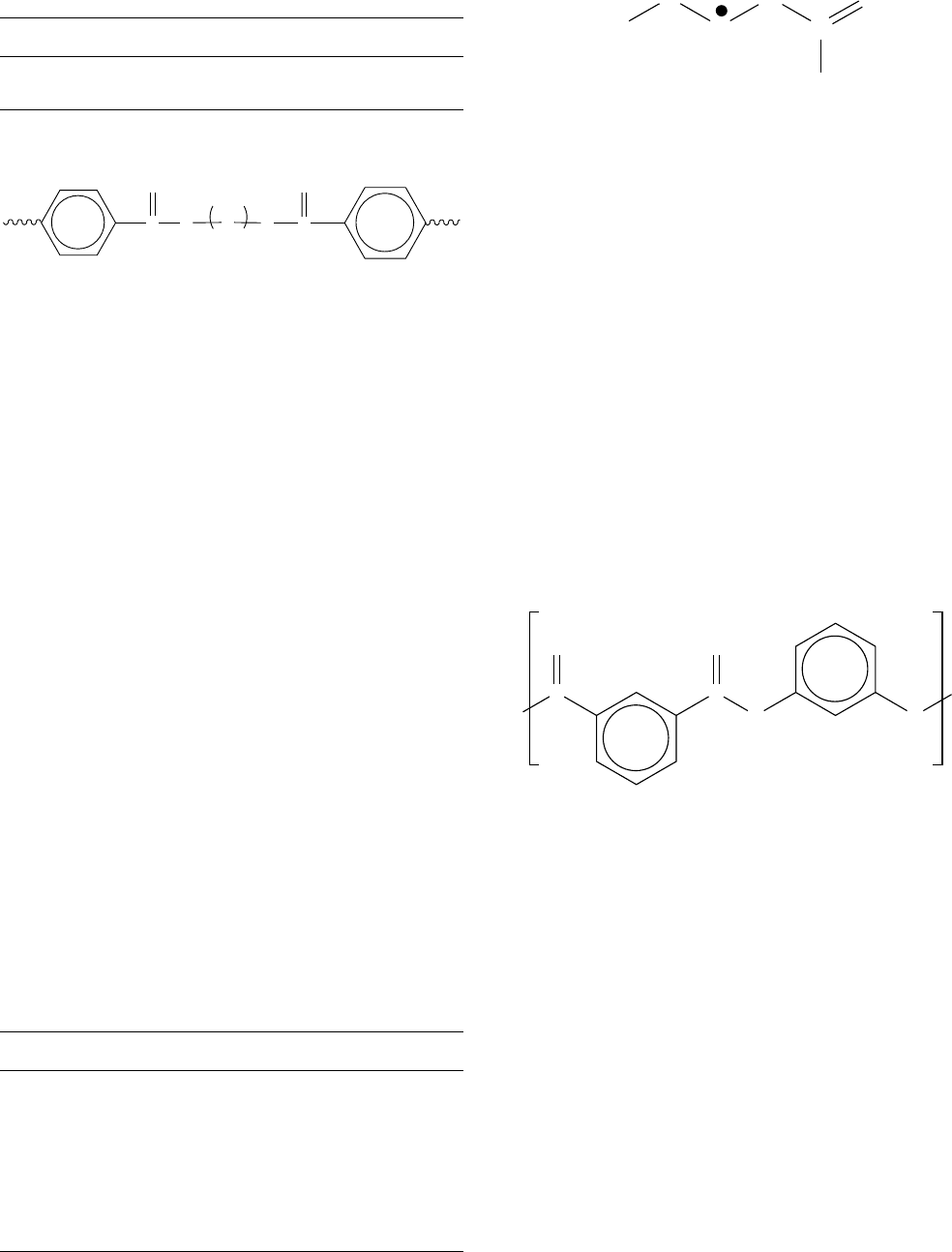Mark James E. (ed.). Physical Properties of Polymers Handbook
Подождите немного. Документ загружается.


polypropylene after g irradiation [94]. An increase in tem-
perature will accelerate the process. For isotactic polypro-
pylene the drop in elongation follows first order kinetics
with an activation energy of 9 kcal=mole
1
[95].
The major gases evolved during irradiation under a
vacuum are hydrogen and methane. In the presence of
oxygen, carbon dioxide and carbon monoxide are also pro-
duced. Table 52.7 gives the yields for gas evolution for
powdered isotactic polypropylene; similar values are found
for polypropylene film [95].
Some values for the yields of crosslinking and scission are
given in Table 52.8 for atactic and isotactic polypropylenes.
The G(S)/G(X) ratio also tends to be a function of dose,
with the value decreasing with increasing dose [97].
The irradiation will also show an effect on the level of
crystallinity and melting point. For example, after a dose of
6 MGy the crystallinity was 73% of the original value and
the melting point changed from 1608C to 1058 C [98].
52.3.4 Fluoropolymers
General Trends in Fluoropolymers
A review of the effects of high energy radiation on fluor-
opolymers has recently been published [99] and provides a
wealth of information. There is a relationship between the
effect of high energy irradiation on a fluoropolymer and the
amount of hydrogen atoms in the fluoropolymer. The trend
can be approximately expressed as follows:
For crosslinking
PVF > PVDF > ETFE > FEP > PFA > PTFE
and for degradation
PTFE > PFA FEP>ETFE > PVDF > PVF
In general, the higher the hydrogen content the higher the
tendency of the fluoropolymer to crosslink. The presence of
hydrogen does lead to dehyrohalogenation (loss of hydrogen
fluoride, HF) upon irradiation. The use of crosslinking pro-
moters are advantageous since relatively high levels of cross-
linking can be achieved without compromising the thermal
stability of the polymer [99]. Recent work has reinforced the
difference in radiation response between perfluoropolymers
and those containing hydrogen with a study of the influence
of low doses (10–200 kGy) of gamma irradiation on PVF,
PVDF, ETFE, FEP, and PFA [100]. Also, gamma irradiated
PVF has been shown to have much better UV stability than
gamma irradiated PVDF [101].
52.3.5 Perfluoropolymers
Poly(tetrafluoroethylene) (PTFE) is very sensitive to
irradiation with either an electron beam or g source. It
predominately undergoes degradation when irradiated
[102,103] in fact high energy irradiation is used commer-
cially to induce degradation to reduce and control the mo-
lecular weight of PTFE. The effect of irradiation on the high
temperature (380 8C) viscosity measurements and the num-
ber average molecular weight are shown in Table 52.9.
The effect of gamma irradiation on the physical properties
of PTFE film are shown in Table 52.10. The falloff in physical
properties is dramatic, even after irradiation in vacuo fol-
lowed by exposure to air. The radicals produced by irradiation
have been shown to have a long lifetime even after heating to
300 8C [103]. By looking at the electron spin resonance
spectrum, radical I is detected for irradiation in vacuo and
peroxy radical II is detected after exposure to air [105].
TABLE 52.5. Yields for crosslinking for a range of
polyethylenes [33].
Resin Density G(X)
LDPE 0.920 1.09
LDPE 0.935 0.8
LDPE 0.930 1.09
HDPE 0.962 1.0
HDPE 0.950 0.70
HDPE 0.945 0.50
HDPE 0.962 1.1
LLDPE 0.937 1.0
LLDPE 0.924 0.96
LLDPE 0.919 0.99
TABLE 52.6. Variation in the tensile strength, modulus of elasticity, elongation, and some electrical properties with irradiation
dose in polypropylenes.
Dose (kGy) 0 1,000 280 800 1,200 1,600
Tensile strength (MN m
2
) 37.5 35.1 30.0 17.1 18.0 16.5
Modulus of elasticity (MN m
2
) 1.45 1.35 1.30 1.20 1.15
Elongation (%) 900 200 90 50 40 20
Dielectric rigidity (MV m
1
) 168 165 150 100 99 98
Electrical permittivity (@ 50 Hz) 2.19 2.16 2.20 2.17 2.20 2.34
C
F
F
C
F
C
F
F
C
F
F
C
F
C
F
F
O
O
Radical I Radical II
THE EFFECTS OF ELECTRON BEAM AND g-IRRADIATION ON POLYMERIC MATERIALS / 875

An interesting, and somewhat surprising effect of high
energy irradiation on PTFE is an increase in the level of
crystallinity at relatively modest doses (< 1 MGy) [106–
108]. The changes in crystallinity with increasing dose are
shown in Table 52.11 [107]. By studying the change in
specific volume for PTFE it has been shown that when the
irradiation dose is increased beyond 1 MGy, the trend is
reversed and the crystallinity level starts to decrease; that is,
the specific volume will start to increase [108].
The explanation for the increase in crystallinity at rela-
tively low irradiation doses is chain scission when irradiated
in the presence of oxygen. Scission will relieve stresses or
entanglements within the polymer, leading to a lower mo-
lecular weight, more mobility, and further crystallization. It
is well established that for PTFE the lower the molecular
weight, the higher the density and correspondingly, the
higher the crystallinity.
Recently, irradiation of PTFE in vacuo has shown evi-
dence of crosslinking when the temperature during irradi-
ation is above 200 8C. There is a significant increase in the
tensile strength and elongation, measured at 200 8C, for
PTFE that had been irradiated (2 kGy) above the melting
point of 327 8C (330–340 8C), in vacuo [109,110]. Radical
I may well be the source of crosslinking for in vacuo irradi-
ation at high temperature.
The electron beam irradiation of a series of perfluoro
copolymers of PTFE shows that the copolymers with hexa-
fluoropropylene (HFP), octafluorobutylene, and perfluoro-
heptene-1 undergo crosslinking when irradiated at a
temperature of between 200 – 250 8C [111]. On the other
hand, irradiation of poly(hexafluoropropylene) and a co-
polymer of HFP and perfluoroheptene-1 underwent scission.
The crosslinking of FEP at above the T
g
has been mentioned
earlier [49,50]. All these evaluations involved the determin-
ation of a change in the melt viscosity. For a series of FEP
polymers with levels of HFP, from 4.7% to 29.8%, the
higher the level of HFP the larger the increase in melt
viscosity after irradiation at 250 8C in nitrogen [111].
The yields of volatile gases evolved after the irradiation
of PTFE and FEP in vacuo and air [112] are given in Table
52.12. The results show relatively low yields in vacuo, but in
oxygen the gas yield is high and almost entirely comprises
carbonyl fluoride (COF
2
).
Irradiation of the copolymers of PTFE at ambient
temperature will generally lead to degradation of the poly-
mer. Both FEP and poly(tetrafluoroethylene-co-perfluoro-
propylvinylether) PFA undergo predominantly chain
scission which is also accompanied with a reduction of the
mechanical properties [113]. However, with PFA, when the
percentage of the comonomer is at a relatively high level,
ca. 30% of perfluoro (methyl vinyl ether), there is some
evidence of crosslinking [102]. The crosslinking may be
due to the more ‘‘rubbery’’ nature of this copolymer at
ambient temperature.
Poly(perfluoroethers) is another class of polymers that
undergoes chain scission when subjected to high energy
irradiation [114,115]. There appears to be no evidence for
any crosslinking. The main products of degradation are the
gaseous products COF
2
and CF
4
; the G Factors for these
gases are given in Table 52.13 [116,117].
52.3.6 ETFE and ECTFE Copolymers
These polymers are fluorocopolymers that have alternat-
ing units of ethylene and, respectively, TFE or CTFE. They
are sometimes additionally modified with a third perfluoro
monomer.
An increase in the high temperature (200 8C) tensile
properties of the ethylene–tetrafluoroethylene copolymer,
ETFE, after irradiation in nitrogen at room temperature
followed by heat treatment at 162 8C in nitrogen for
20 min indicates some crosslinking [118]. On the other
hand, irradiation carried out in air showed very little cross-
linking [119]. ETFE behaves in some ways similar to poly-
vinylidene fluoride (PVDF) in that there is competition
between crosslinking and scission. Some of the tensile prop-
erties, measured at 200 8C, of irradiated ETFE are shown in
Table 52.14 [119].
ECTFE, the copolymer of ethylene and chlorotrifluoro-
ethylene, has been shown to undergo some crosslinking
TABLE 52.7. Yields for gas evolution for g-irradiation
(300 kGy) of powdered isotactic polypropylene in a vacuum
or in air [95].
Condition G(H
2
) G(CH
4
) G(CO) G(CO
2
)
Vacuum 2.9 0.09 – –
Air 2.5 0.17 1.2 2.1
TABLE 52.8. G-factors for crosslinking and scission for
polypropylenes.
Polymer G(X) G(S) G(S)/G(X)
Atactic PP [96] 0.27 0.22 0.8
Isotactic PP [96] 0.16 0.24 1.5
TABLE 52.9. Molecular weights and high temperature
viscosity of vacuum irradiated PTFE [104].
Dose (kGy) M
n
( 10
6
) Viscosity at 380 8C (poise)
0 >10 3.2 10
11
150 2.5 2.8 10
9
750 2.1 1.4 10
8
750* 0.9 8.0 10
6
*Air sintered material, other materials were vacuum sin-
tered.
876 / CHAPTER 52

after irradiation with g-rays [120], although there is compe-
tition between crosslinking and scission. Table 52.15 gives
some data for high temperature (200 8C) tensile properties.
The increase in both tensile strength and elongation is indi-
cative of crosslinking, although at the higher doses the
elongation starts to fall. The room temperature properties,
Table 52.16, show a maintenance of tensile strength even up
to 700 kGy, but they are accompanied by a steady decrease
in elongation.
52.3.7 Vinylidene Fluoride Polymers
For the major polymer in this series, polyvinylidene fluor-
ide (PVDF), the effects of high energy irradiation have been
studied [99,119]. PVDF is a polymer that undergoes both
crosslinking and scission with relatively high yields for both
processes [121–124].
The radicals formed from electron and proton irradiation
(50–5000 kGy) have been characterized by electron para-
magnetic resonance (EPR). The radicals decay when ex-
posed to normal light; however, when kept in the dark, no
TABLE 52.10. Tensile strength and elongation properties for g-irradiated PTFE film [105].
Condition Dose (kGy) Tensile strength (kg cm
2
) Elongation at break (%) Sample thickness (mm)
Untreated 0 175 104 0.1
Irradiated in vacuo* 10 154 98 0.1
Irradiated in air 10 110 15 0.1
Untreated 0 269 129 0.04
Irradiated in vacuo* 104 136 10 0.04
Irradiated in air 104 0 0 0.04
*Tensile properties were measured in air.
TABLE 52.11. Effect of dose on crystallinity levels of PTFE
after g-irradiation [106].
Irradiation dose (KGy) Density (g/cc) Crystallinity (%)
0 2.17 59
250 2.23 79
500 2.24 83
750 2.24 83
1,000 2.24 83
TABLE 52.12. Yields of volatile gases from the g-irradiation
of PTFE and FEP in vacuo and oxygen [112].
G(CO) G(CF
4
) G(CO
2
) G(total gas)
PTFE (Vacuo) 0.03 0.006 0.08 0.43
FEP(Vacuo) 0.02 0.03 0.10 0.18
PTFE (Oxygen) – n. d.** – 3.5*
FEP (Oxygen) – – – 6.2*
*The main component of the total gas was almost entirely
COF
2
.
**Not detected within the limits of experimentation.
TABLE 52.13. Yields for gas evolution for the electron beam irradiation of a series of poly(perfluoroethers).
Polymer G(COF
2
) G(CF
4
) G(CF
3
CFO)
---(CF
2
--- O --- )
x
---(CF
2
CF
2
--- O --- )
y
7.7 0.35 –
HO---CH
2
CF
2
---O---(CF
2
--- O --- )
x
---(CF
2
CF
2
---O---)
y
---CF
2
CH
2
---OH 6.2 – –
---(CF
2
--- O --- )
x
---(CF(CF
3
)CF
2
--- O --- )
y
1.7 1.1 0.3
---(CF
2
CF
2
CF
2
--- O --- )
x
1.2 0.22
---(CF(CF
3
)CF
2
--- O --- )
x
1.0 0.7 0.1
TABLE 52.14. Tensile properties measured at 200 8C, of irradiated ETFE.
Dose (kGy) Temperature of irradiation (8C) Tensile yield strength (psi) Tensile strength (psi) Ultimate elongation (%)
0 – 347 347 12
7 r. t.* 541 840 545
7 150–198 541 813 421
10 220–245 471 701 340
*Irradiation followed by heat treatment at about 160 8C for 20 min.
THE EFFECTS OF ELECTRON BEAM AND g-IRRADIATION ON POLYMERIC MATERIALS / 877

decay was observed after 180 days [125]. The radical types
identified are:
Previous work had identified the five peaks in the spectra
[126–128]. Radical III is a singlet and is long lived.
The thermal stability of the polymer after irradiation
varies inversely with the radiation dose [129]. The yields
for crosslinking and scission for several PVDF grades and
its copolymers are given in Table 52.17. No substantial
differences have been found for the radiation induced cross-
linking of the a-, b-, and g-crystalline forms of PVDF
[130].
At relatively low doses, < 300 kGy, there is virtually no
change in the room temperature tensile properties of PVDF
when irradiated with an electron beam. For higher doses,
> 300 kGy, there is an increase in the Young’s modulus and
a decrease in both tensile strength and elongation at break
[124]. A recent study of the dependence of irradiation dose
on the physical, chemical, and thermal properties of PVDF
has been carried out [133].
The crystallinity of PVDF films has been shown to in-
crease after irradiation with an electron beam followed by:
(1) aging at ambient temperature for various periods and
(2) uniaxial orientation [134]. The other observation from
this work shows that in addition to the increase in crystal-
linity upon orientation there was a change in the crystalline
form with a shift from the a form to the b form. The ratio of
a to b after an irradiation dose of 200 kGy followed by
aging and orientation was 32:68, and the degree of crystal-
linity increased from 0.40 to 0.66. The explanation for
increasing crystallinity may be similar to that for PTFE, but
may also be due to the effect of orientation.
A study of the irradiation of PVDF in vacuo has demon-
strated the increase in crystallinity at low doses. However,
the crystalline melting point decreased rapidly at approxi-
mately 3 8C/100 kGy between 100 and 300 kGy dose [135].
PVDF is known to exhibit a strong piezoelectric effect
[136] with the Phase I ( b form) being the most effective
crystalline form for piezoelectric activity. Since molecular
relaxation modes also contribute to overall piezoelectricity,
high energy irradiation will affect the piezoelectric activity.
This is due mainly to the effect of crosslinking which will
increase the mechanical strength and change the molecular
mobility of the polymer chains. A restriction in chain mo-
bility will reduce reorientation of the molecular electric
TABLE 52.15. Mechanical properties measured at 200 8Cof
an ECTFE polymer after g-irradiation.
Dose (kGy) Tensile strength (kg=cm
2
) Elongation (%)
01337
40 33 679
70 44 660
100 43 377
700 85 132
TABLE 52.16. Mechanical properties measured at room
temperature of an ECTFE polymer after g -irradiation.
Dose (kGy) Tensile strength (kg=cm
2
) Elongation (%)
0 486 309
40 453 298
70 430 268
100 452 224
700 479 72
CH
2
CF
2
F
2
C
C
F
2
C
H
H
2
C
C
H
2
C
F
and
H
2
C
C
F
C
H
F
C
n
H
2
C
Radical III
TABLE 52.17. Yields of crosslinking and scission for PVDF and copolymers after irradiation.
Polymer G(X) G(S) G(S)/G(X) Remarks
PVDF [121] 1.0 0.3 0.30
PVDF [122] 0.78 0.37 0.47 Solef 1010 Homopolymer
PVDF [131] 0.78 0.8 1.03 KF 1,000 irradiation at 61 8C
PVDF [128] 0.75 0.77 1.03 KF 1100 irradiation at 61 8C
PVDF [128] 0.90 0.85 0.94 Kynar 200 irradiation at 61 8C
PVDF [128] 0.70 0.57 0.81 Kynar 450 irradiation at 61 8C
VDF þ HFP [121] 1.7 1.3 0.76 FluoroelastomerViton A
VDF þ CTFE [121] 0.9 1.4 1.56 Fluoroelastomer Kel-F 3,700
PVDF [113] 0.60 0.29 0.48 Copolymer 3.5% tetrafluoroethylene
PVDF-HFP [122] 1.5 0.58 0.39 Solef 11010 Copolymer 6% (HFP)
PVDF-HFP [121,132] 3.4 1.3 0.4
878 / CHAPTER 52

moments at the interphase. High energy irradiation of
mainly b form PVDF leads to a lowering of the piezoelectric
constant [137] and leads to improvement in the thermal
stability of the b form and a slower piezoelectric decay
[138].
An interesting comparison of the effect of electron beam
irradiation on PVDF and ETFE, which differ only in chem-
ical structure and have the same chemical composition, has
shown that the irradiation has a more detrimental effect on
tensile strength for ETFE than PVDF [139]. In fact, PVDF
shows an increase in tensile strength compared to ETFE
which shows a decease. In both cases, the elongation at
break dropped with increasing dose, indicating crosslinking.
The copolymers of PVDF with trifluoroethylene and tet-
rafluoroethylene generally crystallize into the b form [140].
Irradiation with either electron beam or g-radiation has been
shown to induce solid-state ferroelectric to paraelectric tran-
sition in these copolymers as well as a decrease in their
Curie temperature [141].
52.3.8 Other Fluoropolymers
Poly(vinylfluoride) (PVF) undergoes predominantly
crosslinking when exposed to high energy irradiation [142]
with a G(X) of 3.4 to 5.7 G(S) of 0.95 to 1.6 and G(S)/G(X)
of 0.28. The tensile strength of PVF almost doubles upon
gamma irradiation of 10 kGy indicating the predominance
of crosslinking [113].
Poly(trifluoroethylene) undergoes both crosslinking and
chain scission with the former dominating. The G(X) and
G(S) values are 1.1 and 0.4, respectively [121].
Poly(chlorotrifluoroethylene) (PCTFE) only degrades on
exposure to high energy radiation. The G(S) value is 0.67
from number average molecular weight determination
[132]. The tensile properties degrade with relatively low
doses of irradiation [143,144], Table 52.18, but slightly
less rapid than PTFE. Irradiation in air will eventually give
a yellow powder, as the critical dose for electrical break-
down is approached [145].
52.3.9 Polyvinylchloride
Polyvinylchloride (PVC) is one of the most reactive plas-
tics when irradiated with either an electron beam or g-rays.
The major process is degradation via the loss of hydrogen
chloride gas (dehydrochlorination). The dehydrochlorina-
tion is accompanied by a severe color change to a dark
brown material [146], the color is due to the production of
highly conjugated double bonds [147]. The degradation
process is more pronounced in the presence of air and occurs
after the irradiation has stopped (postirradiation effect) [43].
The dehydrochlorination process is dependent on tempera-
ture and increases with increasing temperature, as does the
postirradiation effect [148]. At 908C, that is, above T
g
,
gelation is observed at relatively low doses (120 kGy).
For irradiation under nitrogen and at 1508C gelation occurs
at < 50 kGy [43], although at temperatures above T
g
thermal dehydrochlorination will also be a major factor.
Some yields for gas evolution under a variety of conditions
are given in Table 52.19.
The physical properties of PVC film show an increase in
elongation at low dose (>0.1 MGy) and then a dramatic fall
off in elongation at 0.3 MGy Above doses of 0.3 MGy the
material becomes brittle and has no elasticity.
When PVC is irradiated at very high doses (20 MGy), a
material is formed that appears to have a structure that is
mainly composed of carbon and in some cases is crystalline
in nature [150,151].
52.3.10 Polyacrylates and Polymethacrylates
These are an interesting group of materials since they are
clear examples of how the structure of the polymer can
dramatically affect the changes that occur with either g or
electron beam irradiation. The poly(alkyl acrylates)
undergo radiation crosslinking, whereas the poly(alkyl
methacrylates) degrade so rapidly that they are used as
positive-working electron beam resists [152]. Tables 52.20
and 52.21 give the yields for crosslinking and scission
TABLE 52.18. Mechanical properties of irradiated PCTFE
[144].
Dose (kGy)
Tensile
strength(psi)
Shear strength
(psi) Elongation (%)
0 2,550 3,410 264
10 2,400 3,650 230
100 1,670 1,850 73
1,000 Failed Failed Failed
TABLE 52.19. G-Factors for degradation of PVC under vacuum and in the presence of oxygen.
Condition G(HCl) G(H
2
) G(CH
4
) G(CO
2
) G(CO) Dose (kGy)
Vacuum [149] 2.38 0.19 0.0013 0.007 0.001 300
Oxygen [110] 3.02 0.2 0.0063 0.115 0.1 300
145 to 908C [19] 5.6 – – – – –
308C [19] 13 – – – – –
708C [19] 23 – – – – –
THE EFFECTS OF ELECTRON BEAM AND g-IRRADIATION ON POLYMERIC MATERIALS / 879

for a series of poly(acrylates) and poly(methacrylates),
respectively.
Modification of the alkyl methacrylate with a silicone
group can cause a shift to a polymer that is more prone to
crosslinking poly(Si butyl methacrylate) [156].
52.3.11 Polyesters
The dominant effect of high energy irradiation on a poly-
ester is chain scission, although both crosslinking and scis-
sion occur. With the aromatic polyesters such as
polyethylene terephthalate (PET) and polybutylene tereph-
thalate (PBT) the aromatic groups will act as protection, and
the yields of any process will have a tendency to be low.
Upon irradiation with an electron beam the aliphatic
polyester, poly(butylene adipate)diol (PBAD) undergoes
predominantly scission at low doses (< 50 kGy) along
with an increase in the level of crystallinity, whereas
above 100 kGy both crosslinking and scission occur and
the level of crystallinity decreases [157].
Although PET is regarded as relatively radiation resistant
polymer, irradiation at relatively high dose (>1 MGy) with
an electron beam in vacuo yields both crosslinking and
scission with crosslinking predominating [158]. The ini-
tially semicrystalline material also becomes completely
amorphous after high doses. Poly-1,6-hexamethylene ter-
ephthalate (PHT) behaves in a similar manner to PET but
has higher yield of crosslinking. There is some evidence that
both polymers undergo some crosslinking in the crystalline
region as well as the amorphous region [159]. The radical
produced from PET is shown as radical IV; there is evidence
for the radical in both the amorphous and crystalline states.
Two different decay rates are observed, the fast decay being
attributed to the amorphous region and the slower decay to
the crystalline region [160].
Irradiation of PET, in vacuo, is dose rate dependent [161]
with g-irradiation resulting in more degradation, leading to
the production of acid groups, –COOH and evolution of the
gases CO
2
, CO, H
2
and CH
4
[162]. The yields of these
products are shown in Table 52.22.
There appears to be some relationship between the num-
ber of methylene (---CH
2
---) groups in poly(alkylene tereph-
thalates), structure III, and irradiation, with even number of
methylenes having a different effect in magnitude to the odd
number of methylenes [164,165].
TABLE 52.20. The yields for crosslinking G(X), scission G(S) and the ratio G(S)/G(X) for a series of poly(alkyl acrylates).
Polymer G(X) G(S) G(S)/G(X)
Poly (methyl acrylate) [37] 0.5 – 0.07
Poly (ethyl acrylate) [153] 0.07 0.07 0.23
Poly (n-butyl acrylate) 0.21 [153] – 0.07 [37], 0.14 [153]
Poly (iso-butyl acrylate) [37] – – 0.07
Poly (sec-butyl acrylate) [37] – – 0.10
Poly (tert-butyl acrylate) [37] – – 0.3–0.35
TABLE 52.21. The yields for crosslinking G(X), scission G(S) and the ratio G(S)/G(X) for a series of poly(methacrylates).
Polymer G(X) G(S) G(S)/G(X)
Poly methyl methacrylate – 1.63 (vacuo) –
Poly methyl methacrylate – 0.77 (air) [154] –
Poly phenyl methacrylate – 0.44 [155] –
Poly benzyl methacrylate – 0.14 [155] –
Poly (1-naphthyl methacrylate) – 0.14 [155] –
Poly (2-naphthyl methacrylate) – 0.19 [155] –
Poly (Si methyl methacrylate) [156] 0.11 0.25 2.3
Poly (Si ethyl methacrylate) [156] 0.14 0.21 1.5
Poly (Si propyl methacrylate) [156] 0.54 0.58 1.07
Poly (Si Butyl methacrylate) [156] 0.99 0.77 0.78
C
O
O
H
2
C
H
C
O
C
O
Radical IV
880 / CHAPTER 52

52.3.12 Polyamides
Polyamides are classed in the family of crosslinking
polymers when irradiated with either electron beam or g-
rays. Both crosslinking and scission occur, the yields for
both processes G(X) and G(S) have been shown to be
independent of the irradiation dose [166] but have been
shown to be dependent on the number of hydrogen atoms
or methylene groups in the amine residue [167]. Table 52.23
gives the yields of crosslinking and scission for a series of
dry polyamides.
The yield of crosslinking correlates well with the number
of methylene groups (---CH
2
---) present in the polyamide
structure. Absorbed water in the polyamide enhances cross-
linking at higher concentration, and inhibits the process at
low concentration. The presence of water does not appear to
significantly affect the scission process.
Polyamides show a color change upon irradiation with
either electron beam or g-rays; the change is a consequence
of radical formation. The radical is generally formed on the
a-carbon, adjacent to the amide nitrogen [168], (radical V).
Blocking of the hydrogen atom on the a-carbon with, for
example, phenyl groups (Nylon MPD10) leads to a large
reduction in the yields of both crosslinking and scission.
As with many other polymers, the effects of irradiation on
the physical properties of polyamides are highly dependent
on the atmosphere during irradiation. For example, irradi-
ation of a high tenacity Nylon 6,6 with an electron beam in
an atmosphere free of oxygen showed only a 4% loss of
tensile strength after 200 kGy and 35% loss after
2,000 kGy; the elongation to break showed little change.
However, under similar irradiation conditions in air, after
2,000 kGy the tensile strength retention was 19% and the
elongation to break was about a third of the original value
[169].
Aromatic polyamides are much more resistant to irradi-
ation than aliphatic polyamides, much of the effect is due to
the protective effect of the aromatic groups. The highly
aromatic polyamide, Nomex
1
, can retain about 80% of its
tensile strength after a 6,000 kGy dose in air [170].
52.3.13 Polystyrene
Polystyrene is relatively resistant to the effects of high
energy irradiation due to the ‘‘protective’’ effect of the
aromatic groups. It does undergo crosslinking as the dom-
inant process [171,172] with yields for crosslinking G(X)
being in the range, 0.019 to 0.051, depending on the method
of determination. The effect of the irradiation temperature
has already been discussed [44] in section 52.2.7.
The main volatile material evolved during the irradiation
of polystyrene is hydrogen, the yield for hydrogen G(H
2
)is
in the range, 0.022–0.026 with g-irradiation [38,173,174].
Small amounts of benzene and methane have also been
detected after irradiation with G(C
6
H
6
) and G(CH
4
) being
0.008 and 10
5
, respectively [38].
TABLE 52.22. Yields for the products of electron beam and
g-irradiation of PET in vacuo [163].
G(H
2
) G(CO) G(CO
2
) G(X) G(S) G(CH
4
)
g-rays 0.016 0.11 0.17 – >0.8 0.003
E. beam 0.016 – 0. 08 0.08 0.16 –
TABLE 52.23. Yields of crosslinking and scission for a series
of polyamides [131].
Polyamide G(X) G(S)
Nylon 6 0.67 0.68
Nylon 6,6 0.50 0.70
Nylon 6,10 0.62 0.76
Nylon 11 0.92 0.85
Nylon 12 0.92 0.85
Nylon 10,10 1.12 1.10
Nylon 12,10 1.14 1.10
Nylon MPD10 0.07 0.07
C
O
O
H
2
C
C
O
O
n
Structure III
R
H
2
C
C
H
H
N
C
O
R'
Radical V
CC
* N
H
N
H
*
O O
n
NOMEX
THE EFFECTS OF ELECTRON BEAM AND g-IRRADIATION ON POLYMERIC MATERIALS / 881

The closely related polymer poly(a-methylstyrene)
undergoes scission when irradiated with high energy [175]
illustrating the importance of polymer structure. Polystyrene
has structure I whereas poly(a-methylstyrene) has structure
II and readily degrades [173]. Table 52.24 gives some cross-
linking and scission yields for a variety of polystyrenes. The
p-bromostyrene undergoes a high level of crosslinking,
whereas the p-cyano and p-nitro show relatively high sta-
bility after irradiation [44].
The physical properties of polystyrene remain relatively
stable even after high doses of irradiation. The hardness,
tensile strength, and shear strength are all within 75% of the
original values up to doses of 10
2
MGy [177]. The glass
transition temperature is reported to increase by about 10 8C
and the crystalline melting point increases to 150 8C after
the irradiation of crystalline isotactic polystyrene to
40 MGy [178].
52.3.14 Polysiloxanes
Polysiloxanes readily undergo crosslinking when irradi-
ated with high energy irradiation. Table 52.25 gives some G
values for crosslinking for a series of polysiloxanes, poly
(dimethyl siloxane) (PDMS), poly(phenylmethylsiloxane)
(PPMS), and poly(diphenylsiloxane) (PDPS)and copolymers
of dimethylsiloxane with phenylmethylsiloxane and diphe-
nylsiloxane. As the percentage of aromaticity increases,
the protective effect of the aromatic group leads to more
radiation resistant polysiloxanes.
The gases evolved upon irradiation of PDMS comprise
hydrogen, methane, and ethane. The total yield of gases is
relatively high; G(Total gas) is 3.0 for PDMS [179].
There is a positive temperature effect, in that increasing
temperature leads to increasing yield for crosslinking. For
example, irradiation of a 1,000 centistokes dimethylsiloxane
fluid gave G(X) values of 2.6, 2.8, 3.1, and 4.7 at 78 8C,
0 8C, 20 8C, and 150 8 C, respectively [182].
The curing of silicone elastomers by irradiation leads to
the typical properties of a cured elastomer, that is, an in-
crease in hardness and tensile strength. Interestingly, the
curing of PDMS using a peroxide cure system is very
inefficient [183].
52.3.15 Highly Aromatic Polymers
All of the highly aromatic polymers are resistant, relative
to the nonaromatic polymers, to irradiation with either elec-
tron beam or g-rays. When irradiated in a vacuum many of
these polymers are very stable and can show no change in
physical properties even after high beam doses. For ex-
ample, Kaptone and Vespele aromatic polyimides have
been shown to have resistance to both g-rays and electron
beams up to doses of 100 MGy of irradiation [184]. In the
presence of oxygen, the physical properties of the aromatic
polymers can be dramatically changed. For example, an
aromatic polysulfone showed no change in the flexural
strength after irradiation with g-rays to 6 MGy, in vacuo.
On the other hand, when the irradiation is carried out in the
TABLE 52.24. Crosslinking and scission yields for a series of polystyrenes.
Polymer G(X) G(S)
Polystyrene [176] 0.019 – 0.051 0.0094 – 0.019
Poly (a-methylstyrene) [174] – 0.25
Poly (p-Methylstyrene) [44] 0.061 –
Poly (p-Methoxystyrene) [44] 0.074 –
Poly (p-Bromostyrene) [44] 3.1 –
Poly (p-Chlorostyrene) [44] 0.30 –
Poly (p-Cyanostyrene) [44] No change in viscosity (200 kGy) –
Poly (p-Nitrostyrene) [44] No change in viscosity (1500 kGy) –
TABLE 52.25. Yields of crosslinking for a series of polysiloxanes.
Polysiloxane % Phenyl Groups G(X)
PDMS 0 2.3 [180]
PPMS 50 0.25 [180,181]
PDPS 100 0.07 [180], 0.13 [181]
Dimethyl-/phenyl siloxane copolymer [180] 4.4 2.05
Dimethyl-/phenyl siloxane copolymer [180] 8.7 1.73
Dimethyl-/phenyl siloxane copolymer [180] 21.5 1.09
Dimethyl-/phenyl siloxane copolymer [180] 36 0.53
Dimethyl-/diphenyl siloxane copolymer [180] 17 1.44
Dimethyl-/diphenyl siloxane copolymer [181] 42 0.87
882 / CHAPTER 52

presence of air, the flexural strength dropped to about half
its initial value at relatively low doses of between 0.2 and
4 MGy [185].
The radiation resistance for a series of polyimides(PI),
poly(aryl ether ether ketone) (PEEK), poly(aryl ether sul-
phone) (PES), bisphenol A type Udele poly(aryl sulphone)
(U-PS), and a poly(aryl ester) (U-Polymer) is shown to be
excellent when compared to the related aliphatic polymers.
G values for the evolution of gases were lower by factors of
between 0.01 and 0.001 of the G values for the correspond-
ing aliphatic polymers. From the study of gas evolution, the
order of radiation resistance to g-irradiation is [186]:
Upilexe-R(PI) > Kaptone (PI) > PEEK > PES >
Upilexe-S(PI) {4} U-PS > U-Polymer
The order of resistance for electron beam irradiation is
slightly different [187]:
Upilexe-R(PI) ¼ Upilexe-S(PI) > Kaptone (PI) >
PEEK > PES {4} U-PS > U-Polymer
The polyimides and PEEK show high radiation resistance
to attenuation of physical properties.
The major component gases are: H
2
and N
2
for polyi-
mides; CO
2
and CO for PEEK; CO
2
, CO, and SO
2
for
polysulphones; and CO
2
and CO for U-Polymer. The yields
for gaseous evolution are very low and are given in Table
52.26 for electron beam and Table 52.27 for g-irradiation.
An increase in the glass transition temperature T
g
occurs
when PEEK, either in the crystalline form PEEK-c or the
amorphous form PEEK-a, is irradiated with g-irradiation.
This is indicative that a crosslinking process is occurring
[188].
The irradiation of both amorphous and semicrystalline
poly(phenylene sulfide) (PPS) with an electron beam in
the presence of nitrogen shows no noticeable change in the
mechanical or thermal properties at least to 10
4
kGy [189].
On the other hand, irradiation in air instead of nitrogen
showed a change in both mechanical and thermal properties.
At very high doses, 4 10
4
kGy, the amorphous PPS loses
about 62% of its original tensile strength while the semi-
crystalline PPS loses about 57%. The T
m
also changes,
decreasing by about 10–2718C.
52.3.16 Other Polymers
Table 52.28 gives the G(X) and the G(S) values for a list
of different polymers which will not be discussed in detail.
The polyoxymethylene, cellulose, and polyisobutylene are
all readily degraded upon irradiation.
The irradiation of some composite materials such as
epoxy/graphite, polyimide/graphite, and polysulfone/graph-
ite fibers have shown that the effects for irradiation up to
5 10
4
kGy for electron radiation and up to 3,500 kGy for
g-radiation are negligible provided the irradiation is carried
out in the absence of oxygen [196,197].
Polycarbonates, although they tend to strongly discolor
for unstabilized grades, are relatively resistant to irradiation
showing retention of elongation at yield and tensile modulus
after irradiation up to 1,000 kGy [198].
Polymer Blends
The effect of electron beam irradiation on the miscible
poly(styrene) and poly(vinyl methyl ether) (PVME) blend
has been studied. The poly(styrene), being much more re-
sistant to effects of irradiation, does not offer any protection
to the poly(vinyl methyl ether). Gel content studies indi-
cated significant crosslinking [199]. Further studies of this
TABLE 52.26. Yields for gas evolution G(Gas)(10
4
) for electron beam irradiation.
Polymer G(H
2
) G(N
2
) G(CO) G(CO
2
) G(CH
4
) Dose (MGy)
KaptonE 4.8 0.15 3.5 11 0.89 6.0
PEEK-c 7.5 – 3.4 11.3 0.16 5.8
PEEK-a 12 – 5.2 16 0.22 6.0
UpilexE-R 1.3 0.10 2.1 3.4 0.07 5.0
UpilexE-S 2.3 2.9 1.9 8.2 0.27 5.0
TABLE 52.27. Yields for gas evolution G(Gas)(10
4
) for g- irradiation under vacuum.
Polymer G(H
2
) G(N
2
) G(CO) G(CO
2
) G(CH
4
) Dose (MGy)
KaptonE 2.1 3.6 3.9 7.4 0.89 7.4
PEEK-c 6.3 – 12 5.5 0.14 8.1
PEEK-a 12 – 6.5 12 0.20 7.4
UpilexE-R 0.38 9.8 2.5 5.2 0.08 5.7
UpilexE-S 8.4 13 1.8 15 0.30 8.1
THE EFFECTS OF ELECTRON BEAM AND g-IRRADIATION ON POLYMERIC MATERIALS / 883

polymer blend with gamma irradiation and deuterated PS
showed that a significant amount of grafting between the
blend components occurred [200].
The gamma irradiation of a PS and PMMA blends
showed that the polystyrene did not offer radiation protec-
tion for the PMMA. However, in the copolymer, poly(styr-
ene- co-methylmethacrylate), a protective effect from the
polystyrene was observed [201]. Some radiation(electron
beam and gamma) crosslinking in PS/PMMA has also
been reported [202]. A more recent study has shown the
effect of gamma irradiation on the glass transition tempera-
ture (T
g
) of the miscible blend [203].
Gamma irradiation of the highly miscible poly(vinyl al-
cohol)/polyacrylamide blends up to 100 kGy has been show
to increase the thermal stability of the blend [204].
Recent irradiation studies with blends of PVC and modi-
fiers such as flexible polymers (EVA [205] or ENR –epox-
idized natural rubber [206]) or PFMs (polyfunctional
monomers) have shown that the irradiation achieves more
crosslinking and less degradation (chlorine loss) at lower
doses. Seven PFMs, used at 10 parts per hundred rubber
(phr), were compared for effectiveness for increasing soft-
ening temperature, gel yield and swelling ratio in PVC wire
formulations [207].
EVA blends with PE (usually LDPE) have been studied
and found to be more sensitive in achieving property im-
provements at lower doses [208,209]. In one case, a thermo-
plastic elastomer (TPE) with lower set was formed at < 50
kGy [210,211].
52.4 ADDITIVES
The above review of the effects of high energy irradiation
on polymeric materials has covered the effects on the
‘‘pure’’ polymer, that is, the materials without the addition
of additives except the ones added by the manufacturer,
such as antioxidants.
With many of the materials discussed above, the effect of
high energy irradiation can be dramatically changed by the
addition of additives. For example, more efficient crosslink-
ing can be induced in irradiated polyvinyl chloride by the
addition of polyfunctional materials [212]; atactic polypro-
pylene crosslinking is enhanced when irradiated, in vacuo,
in the presence of nitrous oxide [213]. Many of the materials
can be readily crosslinked at relatively low irradiation doses
using crosslinking promoters, ‘‘prorads’’ [214–216]. The
use of prorads, as well as increasing the crosslinking effi-
ciency can reduce the other effects of irradiation, such as
oxidation or gas evolution, because of the low doses that are
used. In some cases, the need to retard crosslinking may be
required. For example, with a highly efficient crosslinking
polymer such as natural rubber the addition of ‘‘antirads’’
can reduce the yield of crosslinking [217,218].
The addition of fillers to a polymer will increase the back
scattering of the incident radiation if the filler has a higher
electron density than the polymer. The deposition of energy
will in this case increase and will lead to an increase in
crosslinking or scission, depending on which is the more
dominant process.
All the processes of irradiation lead to the production of
radicals. In the presence of monomers these radicals can
initiate grafting on to the polymer chain. This review will
not cover this aspect but an excellent introductory review is
available [219].
52.5 SUMMARY
The effect of high energy irradiation on the properties of
polymeric materials is complex and is dependent on the
polymer structure, molecular weight, polymeric state, and
the crystallinity level. The rate of irradiation and atmos-
phere during irradiation are major factors. Crosslinking,
degradation, and evolution of gases are the major processes.
These processes will lead to property changes in the
polymer.
REFERENCES
1. A. Chapiro, ‘‘Radiation Chemistry of Polymeric Systems,’’ Inter-
science, New York, 1962.
2. A. Charlesby, ‘‘Atomic Radiation and Polymers,’’ Pergamon Press,
London, 1960.
3. ‘‘The Radiation Chemistry of Macromolecules. Volume I,’’ edited by
M. Dole, Academic Press, New York, 1972.
4. ‘‘The Radiation Chemistry of Macromolecules. Volume II,’’ edited
by M. Dole, Academic Press, New York, 1973.
5. ‘‘Radiation Processing of Polymers,’’ edited by A. Singh and
J. Silverman, Hanser, Munich, 1992.
6. ‘‘Irradiation of Polymeric Materials,’’ edited by E. Reichmanis, C. W.
Frank and J. H. O’Donnell, American Chemical Society, 1993.
7. W. L. McLaughlin, Conference on National and International Stand-
ardization of Radiation Dosimetry Part I, p. 89, (1978).
8. R. A. Harrod, Radiat. Phys. Chem. 9, 91, (1977).
9. A. Brynjolfsson, ‘‘Sterilization By Ionizing Radiation,’’ p. 145, Mul-
tiscience, Montreal, 1974.
10. R. Eymery, ‘‘Sterilization by Ionizing Radiation,’’ p. 84, Multi-
science, Montreal, 1974.
11. M. R. Cleland, ‘‘Radiation Processing of Polymers,’’ Chapter 3,
edited by A. Singh and J. Silverman, 1992.
12. K. Tomita and S. Sugimoto, Radiat. Phys. Chem. 9, 576, (1977).
TABLE 52.28. Yields of crosslinking G(X) and scission G(S)
for polymeric materials.
Polymer G(X) G(S) Reference
Polyoxymethylene 6.5 11.1 [190]
Polyisobutylene – 5 [191]
Cellulose – 11 [192]
Polyvinylacetate (O
2
) 0.3 0.07 [26]
Polyvinylacetate (N
2
) 0.15 0.06 [193]
Poly(vinyl ether) 5.8 – [194]
Polypropylene oxide (atactic) 0.15 0.22 [195]
Polypropylene oxide (isotactic) 0.31 0.51 [195]
884 / CHAPTER 52
